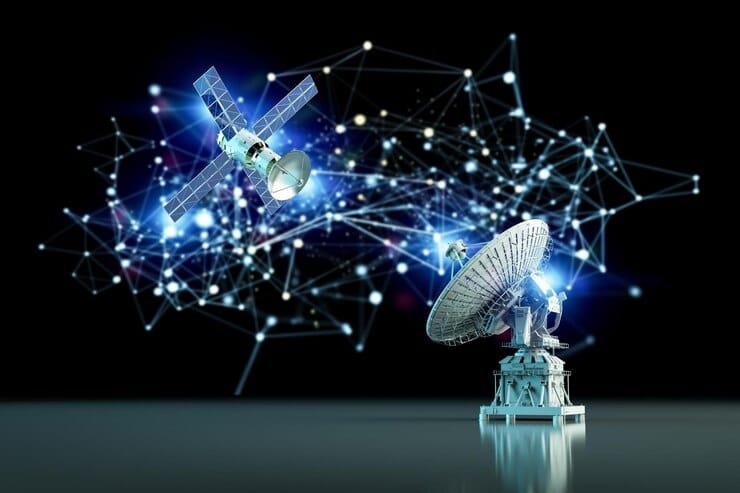Overview: Satellite Tech’s SHOCKING Impact: Reshaping Aerospace & Electronics Forever?
Welcome to a deep dive into the rapidly evolving world of satellite electronics. If you’re a professional navigating the complexities of this field, or a business leader steering your company through aerospace advancements, then you’re in the right place. The landscape of satellite technology is shifting, and the changes are profound. We’re not talking incremental improvements; we’re witnessing a revolution that’s fundamentally altering how we approach aerospace and electronics.
Let’s break down what we’ll explore together:
- Current Landscape: Think about today’s satellites – they’re complex machines, each packed with highly specialized electronics. From communication relays and earth observation systems to navigation tools, these orbiting platforms depend on rugged, reliable, and increasingly sophisticated components. The design, manufacture, and deployment of these systems demand precision at every stage. We’ll begin by taking stock of this existing setup.
- The Revolution Begins: We’ll then move on to what’s causing such a significant impact. What technological advancements are fundamentally changing satellite electronics? We’ll demystify terms like miniaturization, high-throughput processing, advanced materials, and innovative power solutions, showing you how each element is contributing to this shift.
- Why it Matters: Why is it so important for you, a satellite electronics professional or aerospace leader, to pay close attention to these changes? Because these innovations aren’t just theoretical; they have a direct impact on your day-to-day work, from design cycles to mission capabilities and overall market competitiveness. Understanding this transformation will help you make better decisions and develop the next generation of satellite solutions.
- Looking Ahead: Finally, we’ll peer into the future. We’ll explore where these advancements are likely to lead the industry. From lower launch costs and higher bandwidth to new applications in remote sensing and internet connectivity, we’ll equip you with a clear picture of the opportunities and challenges on the horizon. This will help you plan and navigate the future.
This blogpost will be your guide, offering clear insights and practical knowledge. Let’s begin this journey together and uncover how satellite tech is reshaping aerospace and electronics forever!
Understanding the Satellite Electronics Market Landscape
The satellite electronics market is crucial for enabling all satellite functionalities, from communication and navigation to earth observation. It’s a dynamic sector, constantly evolving due to advancements in technology and changing market demands.

Key Trends & Analysis:
1. Positive Trend: Miniaturization and Integration
- Description: There’s a strong push towards smaller, lighter, and more integrated electronic components. Think of systems on a chip (SoC), where multiple functionalities are packed into a single unit.
- Underlying Factors: Advancements in semiconductor technology, demand for lower launch costs (smaller satellites), and the rise of constellations requiring mass production of electronics.
- Impact: Enables smaller satellites (CubeSats, SmallSats), reducing launch costs, and increasing the number of satellites that can be deployed for specific applications.
- Example: Companies like AAC Clyde Space and NanoAvionics specialize in smaller satellites, heavily relying on miniaturized electronics to achieve complex missions in small packages.
- Actionable Insight: Invest in R&D focusing on SoC design, advanced packaging, and lightweight materials. Collaborate with universities and startups that excel in this area.
2. Positive Trend: Commercialization of Space and COTS Components
- Description: A shift from expensive, custom-built space-grade electronics to more affordable, commercially off-the-shelf (COTS) components is occurring.
- Underlying Factors: Increased competition in the satellite sector is forcing cost optimization; improved quality and radiation tolerance of some COTS components is emerging.
- Impact: Lower manufacturing costs and shorter lead times, particularly beneficial for new space companies and constellations deploying numerous satellites.
- Example: SpaceX is known for utilizing COTS components in their Starlink constellation, demonstrating successful large-scale deployment using more affordable hardware.
- Actionable Insight: Implement robust qualification and testing procedures to ensure COTS components meet mission requirements. Prioritize components with a clear path to radiation hardness and reliability.
3. Adverse Trend: Increasing Cybersecurity Threats
- Description: Satellite systems are increasingly becoming targets for cyberattacks due to their crucial role in communications, defense, and critical infrastructure.
- Underlying Factors: The growth in connectivity and the increasing geopolitical significance of space assets.
- Impact: Potential disruption of satellite operations, data breaches, loss of control, and significant financial losses.
- Example: Real-world examples include successful cyber intrusions of ground systems for satellite communications, even though complete satellite control has yet to be breached.
- Actionable Insight: Prioritize cybersecurity throughout the entire satellite lifecycle, from design and manufacturing to operations. Invest in secure communication protocols, encryption methods, and intrusion detection systems.
4. Adverse Trend: Radiation and Environmental Challenges
- Description: Satellites must function in harsh environments, including high levels of radiation, extreme temperatures, and vacuum conditions.
- Underlying Factors: The inherent challenges of space are unavoidable, and higher performance requirements push electronics closer to their limits.
- Impact: Reduced component lifespan, operational errors, and mission failure.
- Example: Radiation hardening is a significant engineering effort for companies such as Cobham Advanced Electronic Solutions, who make components for a variety of harsh environments.
- Actionable Insight: Continue investment in radiation-hardened electronics, testing in simulated environments, and consider redundant systems for critical components. Focus on innovative packaging and thermal management.
5. Positive Trend: AI and Machine Learning Integration
- Description: Artificial intelligence (AI) and machine learning (ML) are being integrated into satellite operations to automate tasks, analyze data, and enhance system efficiency.
- Underlying Factors: The large volume of data generated by satellite systems requires automated processing; AI can improve resource management.
- Impact: Enhanced satellite autonomy, optimized operations, faster data analysis, and reduced reliance on ground control.
- Example: Planet’s data analysis of earth observation images utilizes AI/ML to improve product value.
- Actionable Insight: Explore the use of AI/ML to improve onboard data processing, anomaly detection, and autonomous operations. Focus on algorithm development, data analysis, and on-orbit AI processing techniques.
Conclusion
The satellite electronics market is at an exciting juncture. Companies that are adaptable, innovative, and forward-thinking will thrive. By leveraging the opportunities presented by miniaturization and commercialization while proactively addressing cybersecurity and environmental challenges, businesses can position themselves for success in the evolving space landscape. The integration of AI/ML provides a new frontier for capabilities and efficiency, further enhancing the value of satellite systems.
- Agriculture: Precision farming relies heavily on satellite data. Farmers use GPS-enabled tractors guided by satellite signals to plant seeds and apply fertilizers with pinpoint accuracy. This minimizes waste and maximizes crop yield. Satellites also provide imagery to monitor crop health, identify areas needing irrigation, and predict harvests. A company could develop a sensor system for tractors that integrates GPS, and connects to satellite imagery analysis platforms via a rugged satellite modem, enabling automatic adjustment of planting and application rates. This reduces costs for farmers and increase yield per area, which translates to more profit.
- Maritime Shipping: Shipping companies use satellite communications for real-time tracking of vessels globally. Integrated GPS with onboard sensors transmit data via satellite, allowing fleet managers to monitor locations, speed, and fuel consumption. This optimizes routing, reduces fuel costs, and enhances security. Additionally, satellite communications allows for the transfer of weather data and routing maps directly to the ships, enhancing safety and avoiding storms. A maritime logistics company could incorporate a satellite-based communications hub onto its ships that also handles ship-to-shore data transfers, and predictive maintenance alerts.
- Oil & Gas: Remote exploration and extraction sites often lack terrestrial infrastructure. Satellite communication systems provide reliable connectivity for remote operations such as drilling, monitoring pipelines, and data transfer. Seismic survey data can be transmitted back to headquarters via satellite links. Companies operating in remote or offshore environments can implement satellite-based SCADA systems, using secure satellite links to transmit the data needed for daily operations. This enables remote management of assets and faster reaction to emergencies.
- Healthcare: In remote or disaster-stricken areas, satellite communication is critical for connecting healthcare providers to specialists and transmitting patient data. Telemedicine applications can rely on satellite links when terrestrial options are unavailable. This provides access to medical support in the most inaccessible environments. Implementing lightweight satellite terminals in mobile healthcare units would allow for instant access to secure medical records and expert advice at remote sites during health crisis.
- Emergency Response: During natural disasters, when terrestrial networks are often compromised, satellite communication becomes vital. First responders can use satellite phones and broadband links to coordinate rescue efforts, transmit video feeds of affected areas, and establish communication with affected populations. Disaster relief agencies can create integrated satellite response kits that include portable satellite terminals and communication devices for deploying quickly to impacted regions. This provides critical communication where it’s needed.
These examples show that satellite electronics isn’t just for space exploration. It has become a critical enabler in many business environments, and leveraging it smartly can bring tremendous value and competitive advantage.
- Strategic Acquisitions (Inorganic): Companies are increasingly acquiring specialized firms to rapidly expand their capabilities. For example, a large satellite manufacturer may acquire a smaller company specializing in advanced radio frequency (RF) components. This allows them to quickly integrate cutting-edge technology into their platforms, reducing development time and costs. This eliminates the need for internal R&D on specialized tech and helps consolidate the market share of larger players.
- Vertical Integration (Organic): Many companies are taking steps to control more of their supply chain. By bringing the manufacturing of critical electronics components in-house, they reduce reliance on external vendors. This can improve product quality, reduce lead times, and increase profit margins. We’re seeing satellite companies establishing their own assembly and test facilities, moving away from outsourcing.
- Focus on Software Defined Satellites (Organic): Recognizing the need for flexibility in orbit, companies are shifting to software-defined satellite systems. These systems allow satellite functionality to be reprogrammed after launch, reducing the need to design completely new hardware for each mission. This often involves developing proprietary software platforms that integrate with their existing hardware.
- Investment in Low Earth Orbit (LEO) Constellation Technologies (Organic): The surge in demand for high-speed, low-latency data connectivity has pushed companies to invest heavily in technologies for LEO constellations. This includes developing smaller, more cost-effective electronics, advanced inter-satellite communication systems, and ground infrastructure to support the increasing number of LEO satellites.
- Partnerships & Collaborations (Inorganic): Companies are forming partnerships with technology providers to leverage their expertise. This often involves collaborating with university research labs or semiconductor manufacturers to gain access to leading-edge technologies, such as radiation-hardened chips or miniaturized components. This strategy enables smaller companies to compete in a market dominated by established players.
These strategies demonstrate a shift towards faster development cycles, cost reduction through verticalization, enhanced flexibility through software and a focus on new market opportunities. They are crucial for maintaining a competitive edge in the rapidly evolving satellite electronics industry.

Outlook & Summary: Satellite Tech’s SHOCKING Impact
- The Next 5-10 Years: A Satellite Electronics Revolution: Forget incremental changes. The next decade will see rapid advancements in satellite electronics, driven by demands for higher data throughput, reduced latency, and smaller, more affordable satellites. Expect to see a surge in adoption of advanced processors, AI-powered onboard computing, and innovative power management solutions. These changes aren’t isolated; they’re reshaping the entire aerospace electronics landscape.
- Convergence is Key: Satellite electronics are no longer a niche market. They’re increasingly influencing broader aerospace systems. Think of it this way: innovations like compact radar and communication systems originally developed for satellites are finding their way into aircraft, drones, and even launch vehicles. This convergence creates new opportunities but also demands a more holistic approach to system design.
- Key Takeaway: The central message of this article is clear: the pace of change in satellite electronics is accelerating dramatically, and the impact extends far beyond the satellite itself. This rapid evolution demands that professionals and leaders within aerospace electronics actively adapt and embrace these new technologies to stay competitive. Understanding these shifts is crucial for future success.
- What to Anticipate: We’re looking at smaller more powerful satellites, significantly increased bandwidths and more advanced analytics being done onboard satellite. This pushes the demand for new, more efficient, and resilient components within the satellite systems and beyond.
- The Big Question: So, considering this accelerating pace of change and the convergence within aerospace electronics, how is your organization preparing to adapt to this satellite-driven transformation, and more specifically, are you ready to leverage the opportunities it presents?


